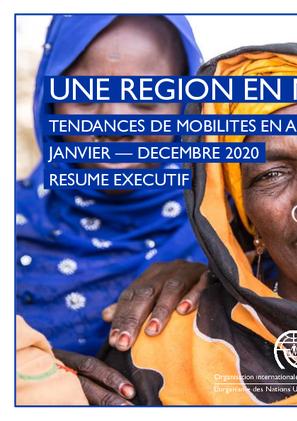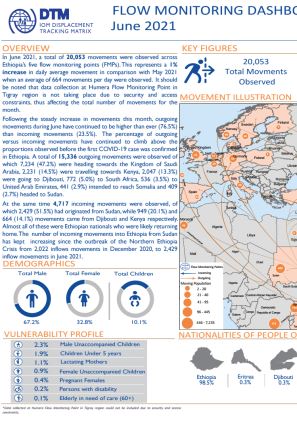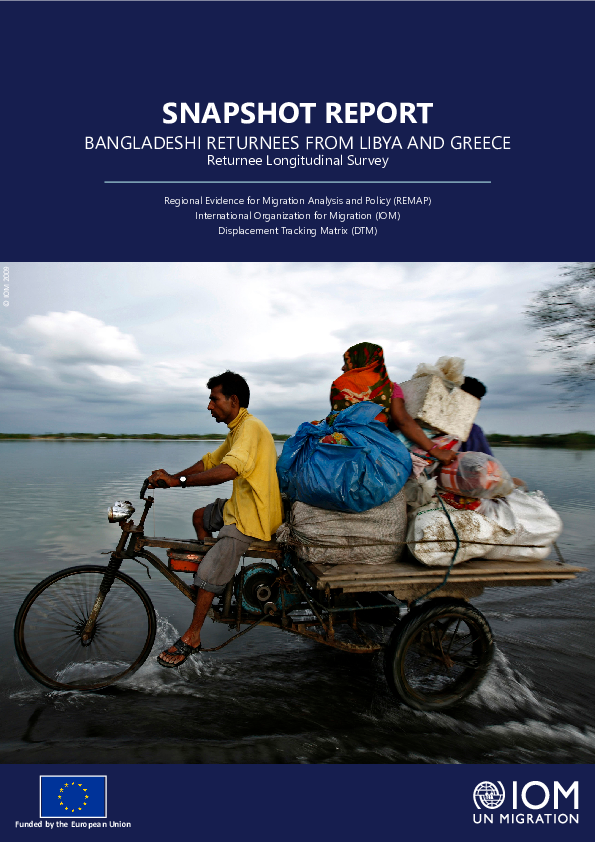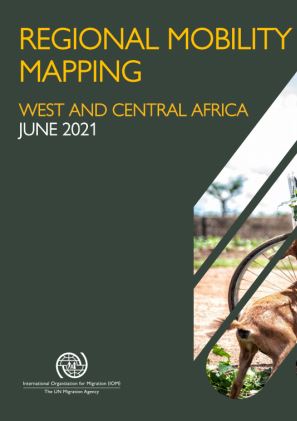-
Countries
-
Data and Analysis
-
Special Focus
-
Crisis Responses
Return migration
The West and Central Africa Mobility Mapping report is a compilation of maps showing various mobility trends and mobility factors for movements to and from the West and central Africa region (forced displacement, transhumance, labour movements, etc.) This work is based on multiple data collection activities implemented by IOM and other actors (UNDESA, Ministries of Interior of various countries) and showcase the complexity of mobility in the region.

Contact
Regional Office Dakar, RODakar-DataResearch@iom.int
Language
French
Activity
- Other
- Survey
- Community Perception
- Flow Monitoring Survey
- Return Intention
- Registration
- Biometric Registration
- Flow Monitoring
- Migrants presence
- Mobility Tracking
- Baseline Assessment
- Points of Entry (PoE)
- Event Tracking
- Site Assessment
Le présent rapport vise à fournir un aperçu sur les tendances principales de mobilités de populations en Afrique de l’Ouest et du Centre en 2020. Il aborde la mobilité régionale selon deux grandes lignes : les déplacements internes et les flux migratoires. Dans chaque section, le rapport présente des tendances primaires de mobilités, les évènements clés, et les profils de populations mobiles observées en 2020. L’édition 2020 de ce rapport contient en outre une section qui examine en détail l’impact de la crise de COVID-19 sur la mobilité régionale.

Contact
DTM Ethiopia, SLOAddisAbabaDTM@iom.int
Language
English
Location
Ethiopia
Period Covered
Jun 01 2021
Jun 30 2021
Activity
- Flow Monitoring
In June 2021, a total of 20,053 movements were observed across Ethiopia’s five flow monitoring points (FMPs). Following the steady increase in movements this month, outgoing movements during June have continued to be higher than ever (76.5%) than incoming movements (23.5%). The percentage of outgoing versus incoming movements have continued to climb above the proportions observed before the first COVID-19 case was confirmed in Ethiopia.
A total of 15,336 outgoing movements were observed of which 7,234 (47.2%) were heading towards the Kingdom of Saudi Arabia, 2,231 (14.5%) were travelling towards Kenya, 2,047 (13.3%) were going to Djibouti, 772 (5.0%) to South Africa, 536 (3.5%) to United Arab Emirates, 441 (2.9%) intended to reach Somalia and 409 (2.7%) headed to Sudan. At the same time 4,717 incoming movements were observed, of which 2,429 (51.5%) had originated from Sudan, while 949 (20.1%) and 664 (14.1%) movements came from Djibouti and Kenya respectively. Almost all of these were Ethiopian nationals who were likely returning home. The number of incoming movements into Ethiopia from Sudan has kept increasing since the outbreak of the Northern Ethiopia Crisis from 2,022 inflows movements in December 2020, to 2,429 inflow movements in June 2021.

Contact
DTM South Sudan, SouthSudanDTM@iom.int
Language
English
Location
South Sudan
Period Covered
May 01 2021
May 31 2021
Activity
- Flow Monitoring
DTM’s Flow Monitoring Registry (FMR) surveys people on the move at key transit points within South Sudan (SSD) and at its borders. It provides an insight into mobility trends, migration drivers and traveller profiles to inform programming by humanitarian and development partners and by the government, complementing DTM’s monitoring of COVID-19 mobility restrictions. In total, 23 Flow Monitoring Points (FMPs) were active in May 2021, surveying internal flows and cross-border travel with Uganda (UGA), the Democratic Republic of Congo (DRC), Sudan (SDN), Ethiopia (ETH), Kenya (KEN) and the Central African Republic (CAR). A new FMP was activated at Nadapal (Kapoeta East) along the Kenya border, while data collection at Renk North Checkpoint was again suspended as a result of access issues. Figures are only indicative of existing trends among respondents at the active FMPs since DTM does not have full coverage of cross-border or internal flows. Participation in the survey is voluntary and anonymous.
Please click here to access a summary dataset.

Contact
DTM South Sudan, SouthSudanDTM@iom.int
Language
English
Location
South Sudan
Period Covered
Apr 01 2021
Apr 30 2021
Activity
- Flow Monitoring
DTM’s Flow Monitoring Registry (FMR) surveys people on the move at key transit points within South Sudan (SSD) and at its borders. It provides an insight into mobility trends, migration drivers and traveller profiles to inform programming by humanitarian and development partners and by the government, complementing DTM’s monitoring of COVID-19 mobility restrictions. In total, 25 Flow Monitoring Points (FMPs) were active in April 2021, surveying internal flows and cross-border travel with Uganda (UGA), the Democratic Republic of Congo (DRC), Sudan (SDN), Ethiopia (ETH) and the Central African Republic (CAR). At the beginning of April, Ariath FMP in Aweil North was relocated to Jaach, while Bentiu (Bimruok) was relocated to Bentiu (Suksita) to better capture relevant migration flows, with 23 of the 25 FMPs active at any one time. Figures are only indicative of existing trends among respondents at the active FMPs since DTM does not have full coverage of cross-border or internal flows. Participation in the survey is voluntary and anonymous.
Please click here to access a summary dataset.

Contact
DTM REMAP Pakistan isbdtmremapteam@iom.int
Language
English
Location
Pakistan
Snapshot Date
Jul 12 2021
Activity
- Survey
This report is part of the outputs under the European Union funded project “Displacement Tracking Matrix Regional Evidence for Migration Analysis and Policy (DTM REMAP)”. The objective of DTM REMAP is to strengthen the evidence-based formulation and implementation of humanitarian and development policy and programming on migration and forced displacement in the Islamic Republic of Afghanistan, People’s Republic of Bangladesh, Islamic Republic of Iran, Republic of Iraq and the Islamic Republic of Pakistan through the use of the Displacement Tracking Matrix (DTM).

Contact
REMAPBD@iom.int
Language
English
Location
Bangladesh
Snapshot Date
Jul 09 2021
Activity
- Survey
- Return Intention
This report is part of the outputs under the European Union funded project “Displacement Tracking Matrix Regional Evidence for Migration Analysis and Policy (DTM REMAP)”. The objective of DTM REMAP is to strengthen the evidence-based formulation and implementation of humanitarian and development policy and programming on migration and forced displacement in the Islamic Republic of Afghanistan, People’s Republic of Bangladesh, Islamic Republic of Iran, Republic of Iraq and the Islamic Republic of Pakistan through the use of the Displacement Tracking Matrix (DTM).

Contact
DTMBurundi@iom.int
Language
French
Location
Burundi
Period Covered
Mar 01 2021
Mar 31 2021
Activity
- Survey
- Return Intention
Selon les données des évaluations de base de la Matrice de Suivi des Déplacements (DTM, en anglais Displacement Tracking Matrix) de janvier 2021, les résultats montrent que 113 841 personnes (25 475 ménages) étaient déplacées internes. 81% des déplacements étaient dus aux désastres naturels et 19% dus à d’autres raisons (conflits, situation sociopolitique, etc).
L’Organisation Internationale pour les Migrations (OIM) en collaboration avec le Gouvernement du Burundi, a conduit une enquête auprès des ménages déplacés, sur les intentions de retour, les causes empêchant le retour et la situation socioéconomique des ménages déplacés internes.
This report calls for a comprehensive and contextualized understanding of migrant vulnerability across the most popular West and Central African migration routes – examining risk and protective factors at the individual, household, community and structural levels – to stimulate the development of prevention-based protection frameworks to assist migrants in need.
The report is based on an analysis of DTM flow monitoring survey (FMS) data gathered from 110,402 migrants of 73 different nationalities at 39 flow monitoring points (FMPs) (exit, entry and transit) in seven countries in West and Central Africa in 2018 and 2019 (namely, Burkina Faso, Chad, Guinea, Mali, the Niger, Nigeria and Senegal), as well as from qualitative data gathered from 11 expert interviews in 2020 during the COVID-19 pandemic. It documents the varied and complex migration patterns occurring within West and Central Africa, the profiles of migrants, their ongoing experiences at numerous points along the migration routes, and the different protection issues and obstacles they face throughout the course of their journeys.
Driven by these data, this report aims to: (a) Generate an evidence-based analysis of the tightly interwoven geographic, cultural and economic patchwork that constitutes West and Central African migration for the benefit of IOM and other migration-related international organizations, the broader humanitarian community, policymakers and other relevant stakeholders; (b) Provide evidence-based programming recommendations on protection and assistance tailored to the specific needs, trajectories and vulnerabilities of migrants moving within and out of the region; (c) Advance viable harm prevention-based frameworks for assisting migrants in situations of increased vulnerability to harm, with a view to stimulating the development of policies that afford safe and regular migration opportunities for this constituency

Contact
DTMAfghanistan@iom.int
Language
Pashto
Location
Afghanistan
Period Covered
Jan 01 2020
Jun 30 2020
Activity
- Mobility Tracking
- Site Assessment
د بېځایه کېدوونکو د تعقیب سیسټم (DTM) د ټولنې پر بنسټ د اړتیاوو ارزونه (CBNA) د تحرکاتو بنسټیزې ارزونې (BMA) اساسي برخې په توګه د ۲۰۲۰ کال په ډسمبر میاشتې کې د کلیو په کچه ترسره کړه ترڅو په هغو کلیو کې چې تر ټولو زیاتو کورني بېځایه شویو او راستنېدونکو څخه کوربه توب کوي له څو سکټوریزو اړتیاوو څخه چې د تغییر په حال کې دي یو هر اړخیز پوهاوی رامنځ ته شي.
Pagination
- Previous page
- Page 19
- Next page


